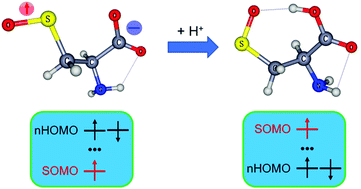Distonic radical anion species in cysteine oxidation processes†
Abstract
Oxidation of cysteine residues constitutes an important regulatory mechanism in the function of biological systems. Much of this behavior is controlled by the specific chemical properties of the thiol side-chain group, where reactions with reactive oxygen species take place. Herein, we investigated the entire cysteine oxidation cycle Cys-SH → Cys-SOnH (n = 1, 2, and 3) using cryogenic negative ion photoelectron spectroscopy and quantum-chemical calculations. The conventional view of the first reversible oxidation step (n = 1) is associated with sulfenate species. Yet our results indicate that an alternative option exists in the form of a novel distonic radical anion, ˙OS–CH2CH(NH2)–COO−, with an unpaired electron on the thiol group and excess negative charge on the carboxylate group. Higher order oxidation states (n = 2 and 3) are thought to be associated with irreversible oxidative damage, and our results show that excess negative charge in those cases migrates to the –SOn− group. Furthermore, these species are stable towards 1e oxidation, as opposed to the n = 1 case that undergoes intra-molecular proton transfer. The molecular level insights reported in this work provide direct spectroscopic evidence of the unique chemical versatility of Cys-sulfenic acid (Cys-SOH) in post-translational modifications of protein systems.



 Please wait while we load your content...
Please wait while we load your content...
